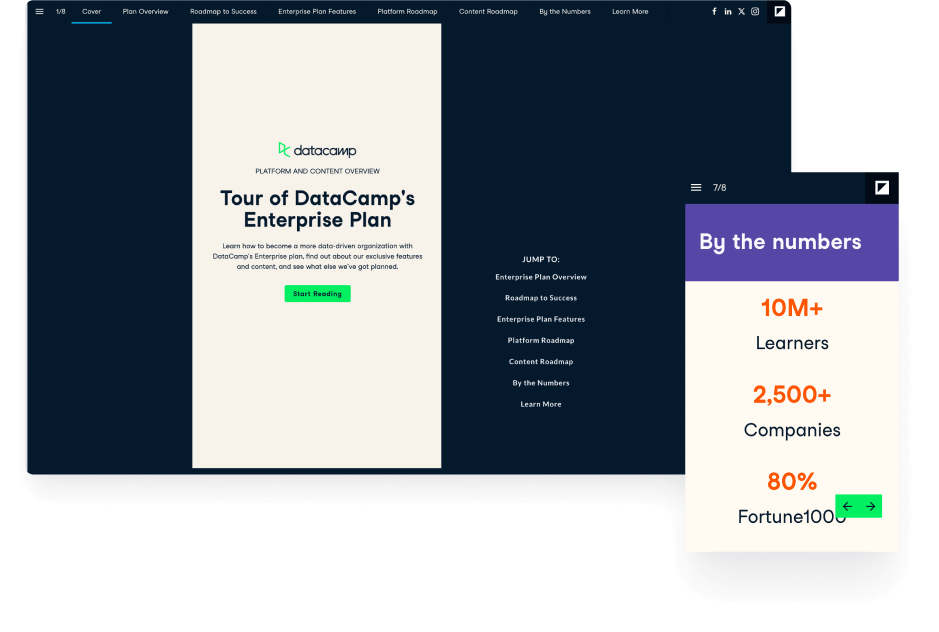As a marketer, it’s easy to get caught up in the excitement of content and campaigns, forgetting the one thing you’re really working towards: Increasing revenue. Let’s face it — you can have the best product out there and the best b2b marketing campaigns ever, but without actual sales, your efforts are being wasted. And the bad news is that closing deals isn’t getting any easier. According to the Salesforce State of Sales Report, 69% of sales professionals agree their job is now harder than ever before.
So, what can marketers do to support their front-line sales colleagues (besides creating brand awareness and generating more leads)? This is where sales enablement comes in. Done well, a sales enablement strategy helps sales teams close gaps and win more deals while ensuring that marketing and sales tell a consistent story to prospects and customers.
What is sales enablement?
Sales enablement is the practice of equipping your sales team with the right tools, information, and content to engage buyers and close deals. In other words, it’s about helping sales reps to share the right message with prospects, at the right time, and in the right way.
What is not sales enablement?
Sales enablement is an ongoing, strategic process of supporting sales teams to hit their targets. Sales enablement shouldn’t be confused with (or reduced to):
Sales operations
While sales enablement focuses on improving the way that sales professionals communicate with their (potential) buyers, the objective of sales operations is to optimize sales processes and improve efficiency by providing them with the tools and data they need to get the job done.
Sales coaching
A sales coach looks at how an individual salesperson is performing, helping them to identify areas for improvement and developing coaching initiatives to support them in reaching their targets. Sales enablement, on the other hand, is more focused on improving how all of your company’s sales reps communicate with prospective buyers.
Buyer enablement
Although very much related, sales enablement and buyer enablement are not one and the same. While sales enablement is all about giving sales the right resources to communicate with prospects themselves, buyer enablement is focused on giving prospective buyers the content they need to make decisions on their own. This could include sales collateral like ROI calculators, diagnostic tools, personalized brochures, and more.
Why is sales enablement important?
So, why bother with sales enablement? We’ve said it before, but we can’t stress it enough: closing deals is only getting harder. This can be attributed to a number of factors, including:
- Economic challenges: Many businesses are starting to tighten their budgets and scrutinize their spending more closely. Because of this, B2B buyers, in particular, are often under more pressure to negotiate and get the most value out of their investments.
- Longer buyer journeys: Related to the first point, buyers are spending more time independently researching products and services — in fact, 81% of sales reps say buyers increasingly conduct research before even reaching out.
- More competition: In 2025, buyers now have more options than ever before. This means that sales teams have to work even harder to differentiate themselves from their competitors and tell a compelling story about their products and services.
In the face of these obstacles, sales enablement can help speed up deal cycles, improve win rates, and make for a more positive, consistent buying experience. Plus, because sales enablement requires marketing and sales to work together, for example, on messaging, an additional benefit of sales enablement can be closer alignment between sales and marketing — which is a huge bonus.
How can marketing support sales enablement?
Sales enablement doesn’t have to be the sole responsibility of marketing teams — but marketing can play a huge role in helping sales teams communicate better. Here are just a few ways that marketing can support sales:
Developing sales enablement content
By creating content tailored to different stages of the buyer’s journey, your marketing team can help sales teams deliver the right message at the right time. This could include creating educational content such as blog posts or e-books for buyers in the awareness stage, sales collateral such as brochures or one-pagers, or even objection-handling materials like FAQ documents and testimonials.
Tip: You could even take it a step further and empower your sales team to create their own content based on professional, on-brand templates.
Sharing relevant insights and data
As a marketer, you have access to a treasure trove of analytics and information about prospect behavior, which could be an invaluable resource for your sales team. Whether it’s the engagement results from your most recent email campaign or a report that reveals which types of content resonate most with prospective customers, sharing relevant data with sales will help them better understand your buyers and how best to communicate with them.
Providing ongoing support
When it comes to sales enablement, collaboration between marketing and sales shouldn’t end after content creation. Your marketing team can continue to support sales by:
- Updating and optimizing content based on feedback from your sales team
- Collaborating with sales on hyper-personalized content
- Continuously analyzing performance data and adjusting content and campaigns accordingly
Simply put, sales enablement content is any kind of content that helps a salesperson communicate more effectively about your company’s products and services. Most sales enablement content falls into two main categories:
Internal sales enablement content
Internal sales enablement content is pretty much any content that’s meant to be used internally by your own sales reps. A few examples of this kind of content include:
- Battlecards answering common buyer questions and explaining how your products or services differ from those of your competitors
- Sales scripts that help reps smoothly handle objections
- Short explainer videos, one-pagers, or reports that give an overview of the competitive landscape
External sales enablement content
External sales enablement content, on the other hand, refers to any content that will be consumed externally by buyers or prospects. A few examples of this kind of content include:
- Industry reports offering prospects in the awareness phase insights that they can apply in their everyday work.
- Informative white papers or e-books providing solutions to your target audience’s pain points, which can serve as helpful lead generation tools.
- Case studies or testimonials from existing customers operating in the same industry as your ideal customer profile (ICP), showing how your products or services helped them to solve a problem — and providing some valuable social proof.
What are sales enablement best practices?
Sales enablement is an ongoing process that differs from business to business, depending on your specific target audience, product, sales team, and more. But there are a few best practices that every sales enablement leader should be aware of:
Get to know your ICP
In sales and marketing, targeting the buyers who actually need your product or service is more effective than the so-called “spray and pray” approach. One of the first steps to effective sales enablement is identifying your ideal customer profile (ICP) and understanding their specific needs, pains, and gains. This way, you can ensure that when you communicate with your target audience, you do so with a story and content that actually resonates with them.
Foster alignment between marketing and sales
As a B2B buyer, getting internal buy-in and budget for a purchase can be a complex and challenging process — and this only becomes harder when a company’s sales and marketing assets are telling totally different stories. In order to ensure consistent messaging across all your content, sales and marketing teams need to align to make sure they’re not contradicting each other.
Personalize sales content
Today’s buyers expect a tailored content experience at every stage of their sales journey, so why not go the extra mile and send them personalized content that’s relevant to their needs? B2B buyers, in particular, are being bombarded with content from every angle, so instead of sending a prospective buyer a generic brochure about your products or services, address them directly and focus on specific solutions that are relevant to your prospect’s specific challenges.
Curious about how to personalize content to boost engagement? Check out this recent blog.
Final thoughts
In today’s competitive and complex sales landscape, sales enablement and marketing-sales alignment aren’t just nice-to-haves — they’re essential if you want to tell a compelling, consistent story that resonates with prospects and drives growth.
By developing content tailored to each stage of the buyer's journey, sharing relevant audience insights and data, and working closely with sales, marketing teams can contribute to speeding up sales cycles, increasing win rates, and improving the overall customer experience.
Looking for innovative ways to step up your sales enablement content? Check out our ultimate guide to effective sales collateral.



